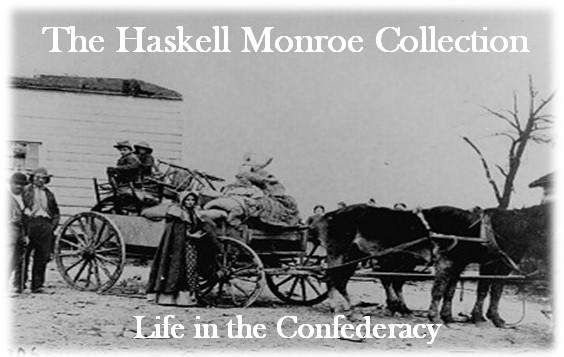Browse Exhibits (11 total)
Historical Events in the Confederate Veteran and the Myth of the Lost Cause
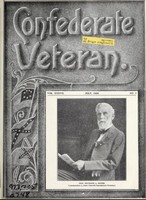
Founded by Sumner Archibald Cunningham, the Confederate Veteran (1893-1932) was one of the leading contributors to the creation of the Lost Cause movement. This exhibit explores how the magazine fueled the Lost Cause movement through the recollection of historical events during the Civil War.
As William Faulkner once said, “the past isn’t dead; it isn’t even past.”
Welcome to the Haskell Monroe Collection: Life in the Confederacy
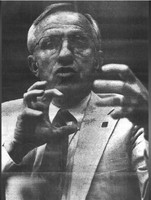
This exhibit is a tutorial for The Haskell Monroe Collection: Life in the Confederacy website. It introduces the collection and outlines how to search and use its content.
Mythologizing Memory? Print Culture and Civil War Memory
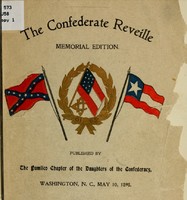
To this day, Americans continue to debate the origins of the Civil War. Was it fought over slavery? States' rights? Tariffs? Or something else entirely? Continued public discussion about the origins, consequences, and memorialization of the war show how culturally relevant it is, with lasting implications up to the present day. While there is a general consensus that the origins of the war were complex, historians overwhelmingly agree that the primary cause of the conflict was slavery. Scholars maintain that the war was more about preserving slavery, its expansion, and white supremacy than any other single factor leading into the conflict.
This exhibit explores this conversation about Civil War causation and the role print culture has played in shaping public and national memory while using sources within our collection to highlight examples.
Role of Religion in the Confederacy

*This Exhibit was done as a project for the 2023 Missouri Scholars Academy and was published by Dulina Dias and Tristan Nokes.
Religion was a dividing factor during the Civil War and in the South, mainly the Methodist and other denominations of Christianity broke away from the Northern churches. Prior events in history such as the Second Great Awakening saw the rise of religion and with the surge of immigrants like the Irish also saw a rising Catholic population. The divide and differences in Christianity were ultimately one of the causes of the Civil War.
In this exhibit, we look at the Confederate government and the general population idealizing the Bible and even misinterpreting the book to further their cause, slavery, and the war as propaganda.
French Perspective On The Civil War
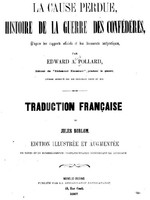
*This Exbhit was done as a project for the 2023 Missouri Scholars Academy and was published by Quincy Carter
The French Empire officially remained a neutral party in the American Civil War, and did not grant the Confederate States offical recognition as a nation independent of the United States. Despite their neutrality in the conflict, the French Empire maintained a diplomatic relationship with the Confederacy, and sent French Consuls to the capital of the Confederate States in Richmond Virginia. This exhibit discusses French experiences during the American Civil War, and their thoughts expressed on the parties involved in the conlict, both Union and Confederacy.
Women and Children in the Confederacy
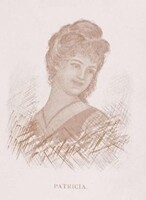
*This Exbhit was done as a project for the 2023 Missouri Scholars Academy and was published by Maggie Hillin, Morgan Stokes, Lauryn Gross.
Women had many new roles with the Confederacy during the Civil War. These roles were present on both the homefront and the warfront. Some took over plantations and production. Others were more involved in war, by becoming nurses, soldiers, and spies. There was also a growth in propaganda within the home, fueled by these women.
The Role of Women During the Civil War
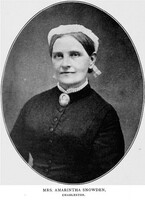
**This Exbhit was done as a project for the 2023 Missouri Scholars Academy and was published by Carleigh Cook and Cynn Nguyen
During the Civil War the role that women played in society changed drasticly. Women who were previosly the home makers in charge of cooking, housework, and raising children took on the roles of nurses, farmers, and plantation masters. In this exhibit you will get a more indepth look at the roles women ihabited, while their husbands and sons were away fighting.
Sherman's March to the Sea and the Homefront
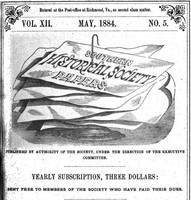
* This Exbhit was done as a project for the 2023 Missouri Scholars Academy and was published by Quinn Reynolds
Sherman's March to the Sea was a famous military expedition in the later stages of the war to completely destroy the Confederacy.
General William Tecumseh Sherman decided that it was in the best interest of the Union Army to cut the Confederacy in two and show the country that they weren't as strong as they portrayed. He practiced hard war, meaning he destroyed the land as he passed thorugh it. He would steal food and resources from farms and burned those places when they left. This psychological warfare significantly affected the morale of the Confederacy and forced the Confederacy to focus a large portion of it's army into defending it's major cities. His main goal was to cut off the South's armies from their supply of resources and morale.
His army rolled through rural Gerogia stealing food and resources and destroying the farms of those who fought back. He captured the major cities Atlanta, GA and Savannah, GA, which destroyed Southern morale. Throughout this conquest, Sherman enacted 'hard war.' This is the idea of destroying the land and resources of the conquered area to ensure their destruction.
Sherman's March to the Sea was an effective manuever to destroy part of the Confederacy and significantly affected the morale and homefront of the Confederacy.
Supplying the South

*This Exbhit was done as a project for the 2023 Missouri Scholars Academy and was published by Ramya Penumacha
How did people get food, clothing, and weapons during a war?
Where, and from who, did it come from?
What were the differences throughout the war, and between the two sides?
In this exhibit, we will aim to investigate how the Confederacy supplied itself throughout the war, the differinces between its soldiers and civilians, and the impact of supplies on the Confederacy, as well as the American Civil War.
The Downfall of Southern Plantation Power
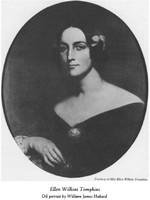
The power of southern plantations starts as an immense social and economic strength pre-war. However, once the war begins the slow downfall of the southern plantations begins and while it is not immediate. The gradual dive into 'insanity' that the Southern plantation owners experience shows the decay of the southern plantation power in a social environment. Not only do the writings of civil war plantation owners show this, but the idea of the Lost Cause does as well. This will be shown in the following documents.
